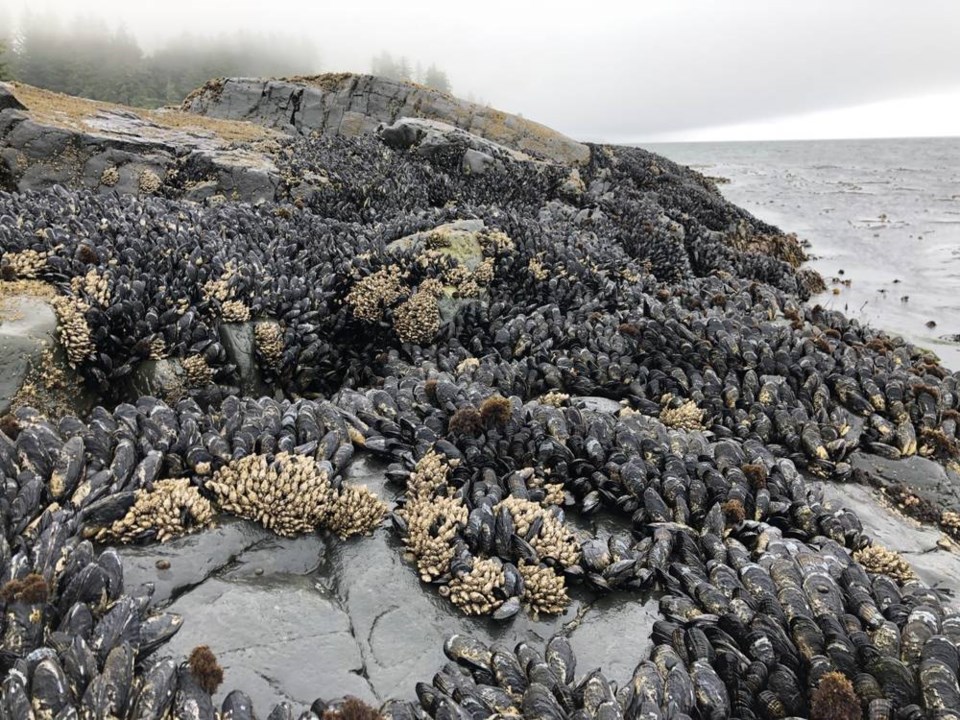Seashore animals in the intertidal zone on Vancouver Island’s west coast appear to have fared better during last month’s record-breaking heat wave than mussels and barnacles on the Island’s east coast and in Vancouver.
Despite that, Chris Harley, a marine biologist at the University of British Columbia who estimated more than one billion seashore animals living along the shore of the Salish Sea may have died during the extreme heat, now thinks that number could be higher.
His initial estimate was based on the rate of mortality in mussels he observed around Vancouver. It takes longer to tell if a barnacle has died because their shells last longer, but it’s now clear they also died off in huge numbers, he said.
A couple of weeks after the heat wave, Harley visited several sites on the Island, where he noticed that areas on the east coast seemed to have been hit as hard as the Vancouver area, but the southwest coast appeared to have been largely spared.
Em Lim, a masters of science student at Simon Fraser University, surveyed mortality rates near Bamfield, where it was a “huge relief” to see the main mussel bed looked pretty normal.
Lim chalks up the difference to the fact that low tides in Bamfield are early in the day, meaning animals in the intertidal zone were covered by water and kept cooler during the hottest time of the day.
The primary mussel species in Bamfield is also different from that in Vancouver.
Harley said more waves and more frequent fog could have kept animals on the shore cooler around Juan de Fuca Strait.
He said he’s worried about the coast having another heat wave before animals recover from the extreme temperatures.
“It’s like getting a sunburn on top of a bad sunburn, because we’ve already lost a lot of those sort of little protective layers, like the seaweeds, and that’s exposed everything underneath, some of which survived. But if there’s another heat wave this summer before the seaweeds recover … then that is going to impact a lot of those survivors,” he said.
Barnacles and mussels provide important habitat for other animals and the full effects of their loss on species such as salmon and migratory sea ducks is not known, Harley said.
>See HEAT WAVE, A2
Shellfish growers have suffered significant losses, especially around Okeover Inlet in the Sunshine Coast region, where farmers are reporting “catastrophic” deaths, said Jim Russell, executive director of the B.C. Shellfish Growers Association, whose 150 members produce about 90 per cent of the shellfish in the province. About three-quarters of farmers’ crops in the Okeover Inlet area have died, which could essentially put some out of business for three years, Russell said.
Around Baynes Sound on the Island’s east coast, farmers are reporting losses of 30 to 40 per cent of their supply.
The association is in the process of trying to quantify financial loss, estimating it at several hundreds of thousands of dollars, Russell said. They’re contacting the provincial and federal governments to see if help is available for shellfish farmers, as there are no industry support programs to recover loss of crops.
Restaurants are starting to feel the effects of the die-off as a result of the heat wave.
Dave Craggs, owner of Ferris’s Oyster Bar, said it has become challenging to source oysters, particularly from farmers around Baynes Sound.
The heat wave further depleted a supply that was already limited as a result of the pandemic, which caused fewer oysters to be planted while restaurants were closed, he said.



